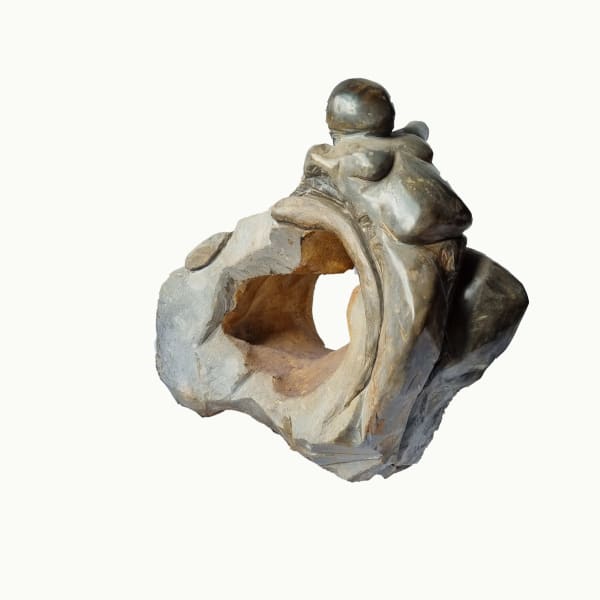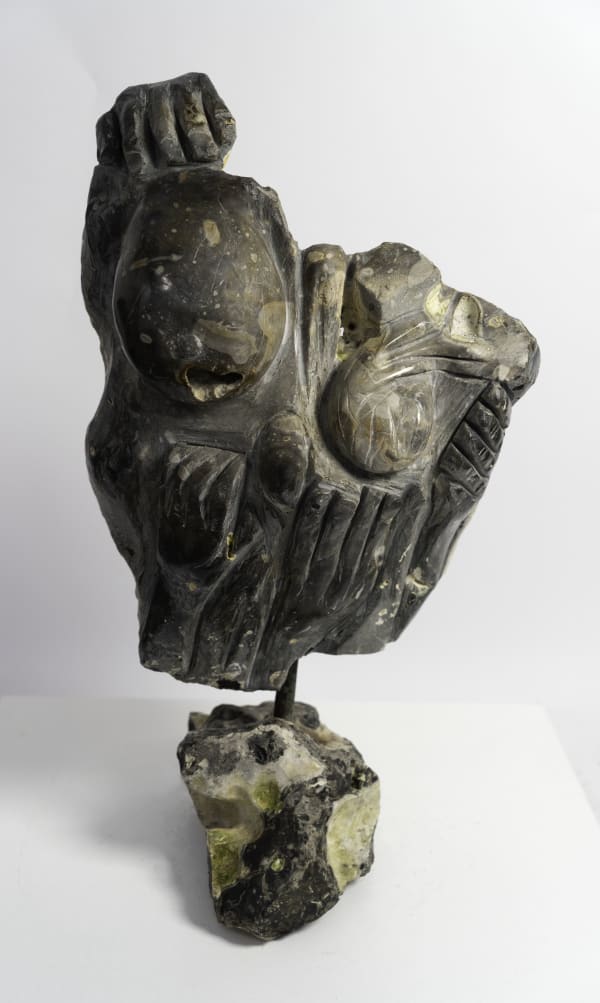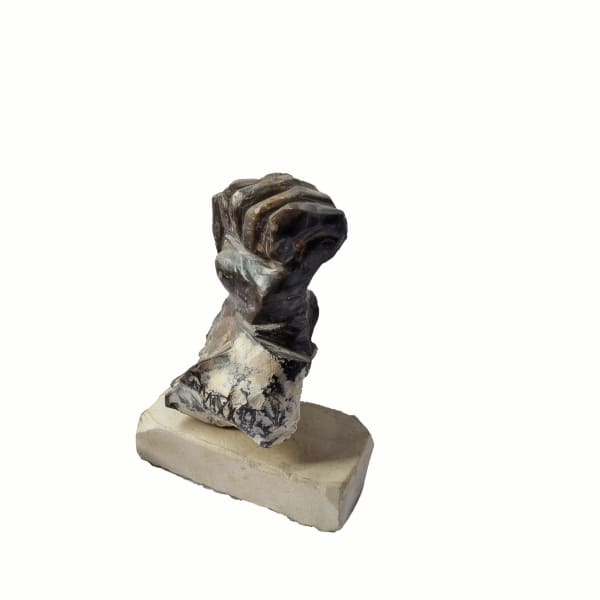Drew Edwards British, b. 1966
Born in 1966, Drew Edwards first trained as an actor before starting his practice as a sculptor at the turn of this century. His journey is one of a self-taught maker who from a very early age followed an urge to respond to an inner calling by sculpting. As a child his family would visit the main museums of Europe every year, and this had a lasting influence on him. Initially carving in wood, he progressed to increasingly uncompromising material and his work is now entirely produced from flint and granite.
Sculpting with flint is an almost impossible undertaking as this material is harder and more brittle than most. Practically no-one can tackle it as a medium for sculpting. There is a clear connection between the ingratitude and beauty of the material and Edwards’s obsessive need to extricate forms from it. Extracting massive flint boulders from a mine in norfolk, Edwards then places them in his home for weeks in order to decipher what the stone will allow him to do. His art emerges from this narrow path between the will to shape and the need to yield, thus informing his practice and adding meaning to his work.
-
 Drew EdwardsThey Know, 2020Flint sculpture, metal and concrete base53 x 22 x 24 cm
Drew EdwardsThey Know, 2020Flint sculpture, metal and concrete base53 x 22 x 24 cm
20 7/8 x 8 5/8 x 9 1/2 inView more details -
 Drew EdwardsCosmos, 2021Flint46 x 24 cm
Drew EdwardsCosmos, 2021Flint46 x 24 cm
18 1/8 x 9 7/16 inView more details -
 Drew EdwardsThinking, 2021Flint Sculpture44 x 16 x 21 cm
Drew EdwardsThinking, 2021Flint Sculpture44 x 16 x 21 cm
17 5/16 x 6 5/16 x 8 1/4 inView more details -
 Drew EdwardsEmperor, 2017Flint75 x 52 x 38 cm
Drew EdwardsEmperor, 2017Flint75 x 52 x 38 cm
29 1/2 x 20 1/2 x 14 15/16 inView more details -
 Drew EdwardsHead, 2021Flint on steel rod and marble base50 x 23 x 29 cm
Drew EdwardsHead, 2021Flint on steel rod and marble base50 x 23 x 29 cm
19 11/16 x 9 1/16 x 11 7/16 inView more details -
 Drew EdwardsLibertin, 2018Flint117 x 37 x 42 cm
Drew EdwardsLibertin, 2018Flint117 x 37 x 42 cm
46 1/16 x 14 9/16 x 16 9/16 inView more details -
 Drew EdwardsRisen, 2021Flint85 x 42 x 28 cm
Drew EdwardsRisen, 2021Flint85 x 42 x 28 cm
33 7/16 x 16 9/16 x 11 1/16 inView more details -
 Drew EdwardsThe Great Creator, 2022Flint and lapis lazuli53 x 22 x 31 cm
Drew EdwardsThe Great Creator, 2022Flint and lapis lazuli53 x 22 x 31 cm
20 7/8 x 8 11/16 x 12 3/16 inView more details -
 Drew EdwardsWomb, 2022Flint64 x 27 x 24 cm
Drew EdwardsWomb, 2022Flint64 x 27 x 24 cm
25 3/16 x 10 5/8 x 9 7/16 inView more details -
 Drew EdwardsBefore we sleep, 2018Flint sculpture25 x 36 x 29 cm
Drew EdwardsBefore we sleep, 2018Flint sculpture25 x 36 x 29 cm
9 13/16 x 14 3/16 x 11 7/16 inView more details -
 Drew EdwardsAlter, 2018Flint44 x 50 x 37 cm
Drew EdwardsAlter, 2018Flint44 x 50 x 37 cm
17 5/16 x 19 11/16 x 14 9/16 inView more details -
 Drew EdwardsHidden, 2019Flint, steel rod42 x 26 x 26 cm
Drew EdwardsHidden, 2019Flint, steel rod42 x 26 x 26 cm
16 9/16 x 10 1/4 x 10 1/4 inView more detailsDrew Edwards, Hidden, 2019£ 4,500.00 -
 Drew EdwardsMiracle, 2019Flint77 x 54 x 32 cm
Drew EdwardsMiracle, 2019Flint77 x 54 x 32 cm
30 5/16 x 21 1/4 x 12 5/8 inView more details -
 Drew EdwardsWheel of Life, 2019Flint44 x 44 x 18 cm
Drew EdwardsWheel of Life, 2019Flint44 x 44 x 18 cm
17 5/16 x 17 5/16 x 7 1/16 inView more details -
 Drew EdwardsAppearing, 2020Flint23 x 32 x 39 cm
Drew EdwardsAppearing, 2020Flint23 x 32 x 39 cm
9 1/16 x 12 5/8 x 15 3/8 inView more details -
 Drew EdwardsBowie Star Man, 2018Flint79 x 41 x 26 cm
Drew EdwardsBowie Star Man, 2018Flint79 x 41 x 26 cm
31 1/8 x 16 1/8 x 10 1/4 in
(height includes steel rod)View more details -
 Drew EdwardsBust, 2021Flint54 x 28 x 18 cm
Drew EdwardsBust, 2021Flint54 x 28 x 18 cm
21 1/4 x 11 x 7 1/16 inView more details -
 Drew EdwardsCaged In, 2020Flintheight 71 x depth 33 cm
Drew EdwardsCaged In, 2020Flintheight 71 x depth 33 cm
27 15/16 x 13 inView more details -
 Drew EdwardsFigure of Past and Present, 2021Flint60 x 22 x 18 cm
Drew EdwardsFigure of Past and Present, 2021Flint60 x 22 x 18 cm
23 5/8 x 8 11/16 x 7 1/16 inView more details -
 Drew Edwardsi can't understand, 2019Flint sculpture and marble base42 x 20 x 22 cm
Drew Edwardsi can't understand, 2019Flint sculpture and marble base42 x 20 x 22 cm
16 1/2 x 7 7/8 x 8 5/8 inView more detailsDrew Edwards, i can't understand, 2019£ 4,500.00 -
 Drew EdwardsYou're still here, 2019Flint Sculpture43 x 25 x 31 cm
Drew EdwardsYou're still here, 2019Flint Sculpture43 x 25 x 31 cm
16 7/8 x 9 7/8 x 12 1/4 inView more details -
 Drew EdwardsJohn Barleycorn, 2018flint sculpture, metal and granite stand64 x 21 x 19 cm
Drew EdwardsJohn Barleycorn, 2018flint sculpture, metal and granite stand64 x 21 x 19 cm
25 1/4 x 8 1/4 x 7 1/2 inView more details -
 Drew EdwardsYouth, 2018Flint71 x 38 x 28 cm
Drew EdwardsYouth, 2018Flint71 x 38 x 28 cm
27 15/16 x 14 15/16 x 11 1/16 inView more details -
 Drew EdwardsCornered, 2019flint85 x 35 x 23 cm
Drew EdwardsCornered, 2019flint85 x 35 x 23 cm
33 7/16 x 13 3/4 x 9 1/16 inView more details -
 Drew EdwardsExtraction, 2022Flint56 x 15 x 19 cm
Drew EdwardsExtraction, 2022Flint56 x 15 x 19 cm
22 1/16 x 5 15/16 x 7 1/2 inView more details -
 Drew EdwardsFist, 2020Flint30 x 14 x 16 cm
Drew EdwardsFist, 2020Flint30 x 14 x 16 cm
11 13/16 x 5 1/2 x 6 5/16 inView more details -
 Drew EdwardsLouisiana, 2022FlintHeight 59 x depth 25 cm
Drew EdwardsLouisiana, 2022FlintHeight 59 x depth 25 cm
23 1/4 x 9 13/16 inView more details -
 Drew EdwardsMonkey, 2017Flint15 x 15 x 21 cm
Drew EdwardsMonkey, 2017Flint15 x 15 x 21 cm
5 15/16 x 5 15/16 x 8 1/4 inView more details -
 Drew EdwardsRussian Soldier, 2022Flint42 x 21.5 x 22 cm
Drew EdwardsRussian Soldier, 2022Flint42 x 21.5 x 22 cm
16 9/16 x 8 7/16 x 8 11/16 inView more details -
 Drew EdwardsSmall Putin, 2022Flint43 x 21 x 16 cm
Drew EdwardsSmall Putin, 2022Flint43 x 21 x 16 cm
16 15/16 x 8 1/4 x 6 5/16 inView more details -
 Drew EdwardsStar Man, 2018Flint76 x 37 x 13 cm
Drew EdwardsStar Man, 2018Flint76 x 37 x 13 cm
29 15/16 x 14 9/16 x 5 1/8 inView more details -
 Drew EdwardsThe Skull, 2017Flint117 x 52 x 34 cm
Drew EdwardsThe Skull, 2017Flint117 x 52 x 34 cm
46 1/16 x 20 1/2 x 13 3/8 inView more details -
 Drew EdwardsWar Figure, 2022Flint34 x 24 x 22 cm
Drew EdwardsWar Figure, 2022Flint34 x 24 x 22 cm
13 3/8 x 9 7/16 x 8 11/16 inView more details
Edwards’s work is bound neither to the values of low or high art nor homage to classical forms embedded in our consciousness. While some of his sculpture makes fleeting reference to modernist sculptors of the early and mid-20th century, from Zadkine to Epstein, these visual associations are pure coincidences. Most of the time the figure is the goal, but the stone can relish in pure abstract forms. Some pieces could be mistaken for Neolithic sacred entities discovered by archaeological excavation. Themes are recurrent: organs, skulls, body parts, gaze. The work can sometimes appear to depict clusters of monsters and extreme human expressions or, on the contrary, the calming presence of bare humanity. Whether ironic or literal, autobiographical or engaged in universal narratives, the pursuit is pathos and emotional gravity surging from the toughest matter to overcome. Like the work itself, the artist is not easily categorizable. He could be described as an Outsider in view of his marginal beginnings, but the definition of this term stands in contradiction with his engagement in the art scene today. However, it is also not quite correct to eliminate him altogether from the Outsider spectrum, such has his own journey been: detached at first from the contexts that normally propel artists in our world.
If there have been interactions with that world, Edwards has taken an unusual path. Two works specifically illustrate this. Firstly, his (anonymous) gift to the Methodist church near Grenfell Tower, which became for many months a sanctuary from this tragedy. The granite elongated figure now stands as a revered symbol of sorrow and consolation at the entrance of the church. Secondly, his monumental Children of the Mediterranean, 2017, a poignant and powerful homage to refugees lost at sea: a large crowd of 91 life-size standing figures of children offered to their cruel destiny, in which the vulnerability of its subjects is paradoxically amplified by the arresting mass of granite. This work is currently exhibited at the Middlesex University Ritomond plinth.
Singular and unclassifiable, Drew Edwards’s work is a significant addition to today’s contemporary art scene.
A special credit goes to the artists Simon English, Neil Gall and Tasha, for discovering and supporting Drew Edwards from the early days. Together they have produced a book, to be published in November 2021, with essays of the personal account of their friendship: Shit Stinks but it’s Warm, Lotus Press, 2021. The book will be available to purchase on this website.
-

Dwelling of the Imagination
Twelve artists are creating an imaginary home interior 29 February - 21 April 2024Twelve artists are creating an imaginary home interiorRead more -

Reminiscence
A Retrospective Journey 18 November - 23 December 2022Reminiscence is a rotating exhibition on some of the highlights of the year at the gallery, with new works and installations.Read more -

Now you can see the universe
A solo exhibition by Drew Edwards 23 September - 6 November 2022This show is Drew Edwards first solo exhibition. Born in 1966, Drew Edwards first trained as an actor before starting his practice as a sculptor at the turn of this...Read more -

CIRCLE AND LIGHT
Summer Exhibition 17 June - 18 September 2022The exhibition includes works by: Fabio Almeida Duncan Cheetham Rosalind Davis Drew Edwards Caroline List Bérénice Mayaux Simon Pike Cathy Rogers Geoffrey Raymond Reeve Karen Vost Julie Westbury James D....Read more -

Winter Salon 2021
IT'S A WRAP! 26 November - 24 December 2021It's a Wrap is the conclusion to a pretty turbulent year world-wide. Covid, the Climate, it has been an 'on and off' year out of self-isolation in which we tried...Read more -

Trans_Formations Finale
1 October - 20 November 2021Read more
91% from Laurent Delaye on Vimeo.










































